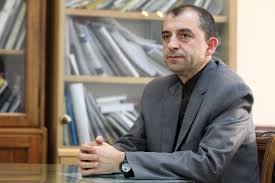Megathrust quake, tusanmi in Iran-Pakistan Makran region lurk around

The Makran region in southeastern Iran and southwestern Pakistan is considered the most probable shoreline for a major tsunami.
Makran is Iran’s only shoreline to an open-sea: the Sea of Oman and Indian Ocean.
The greatest ever recorded earthquake in the Persian plateau and the Makran region is one that happened on November 27, 1945, with a mangnitude of 8.2. It is the only recorded magnitude greater than 8 in the Perisan Plateau.
Fortunately, the quake claimed few lives as the region had low population density.
The massive earthquake caused a large landslide along the Sea of Oman’s coastline, and as a result four large mud volcanoes rose out of water.
The earthquake was accompanied by a complicated fault system with many surface ruptures and fractures.
With the occurrence of recent quakes in the Iranian plateau, a great earthquake is waiting to hit the region at any time.
Another study, using the Makran research findings, shows the possibility of an earthquake and tsunamin in the Persian Gulf.
This study is concerned with the experimental relations between the length, magnitude and fault slip based on which the parameters of tsunami sources are calculated.
After presenting a model, the maximum height of waves is calculated based on specifications of the source and its distance from the shoreline and coastal slopes. According to assessment of tsunami hazard for coastal areas, the maximum tsunami wave in the Persian Gulf can reach heighs of 3.5 meters.
The fault source zone, located in the northern zone of the the Persian Gulf, is very close to the shoreline and after a possible earthquake the generated wave energies do not have enough time to be attenuated, and therefore the wave height is predicted at about 3 meters.
The boundaries of the Makran subduction zone are complex tectonic features. The Makran subduction zone with 800 km length reaches to Minab-Zendan fault, and Chaman fault from west and east ends, respectively.
Annual 4cm convergence of the Makran zone, existence of 9 mud-volcanoes, major earthquake occurrences, existence of 16 volcanoes along the west-east, e.g., Kuh-Soltan volcano in Pakistan, Taftan and Bazman volcanoes in Iran, all indicate that Makran subduction is active.
In spite of high seismicity rate in subduction zones, earthquake occurrence rate is relatively low in the Makran zone. Low dip of penetrating slab, groundwater and thickness of sediments are accounted for low seismicity in the Makran region.

Usually the Makran earthquakes have shallow depth with a distance of 70 km from the Sea of Oman’s coast, but farther into the sea , the depth increases to 80km.
Other studies on the Makran earthquakes reveal that the average return period of magnitude 8 and stronger earthquakes in Makran is approximately 150 years.
A great earthquake caused by a mega-thrust along Makran subduction zone has a 50 percent chance of reoccurance in the Makran subduction region in the next decade.
Recent seismicity in the Makran region, e.g., 16 April 2013 Saravan (Mw=7.8), Goharan-Bashagard (11 May 2013, Mw=6.2) and five events with magnitude 5.5 and above, are the main reasons for the reactivation of this zone.
The 16 April 2013 Saravan earthquake in Makran with strong Mw7.8 killed one person in Iran and 41 in the Pakistani side of Makran.
Low number of victims of the quake was due to low population density on the Iraninan side of Makran and the depth of the quake (the event had the depth of 70km below the earth surface).
Some evidence imply that the normal faulting in this subduction zone especially in the 16 April 2013 earthquake could be an introduction to a major thrust faulting, based on similar consequences in Chile in the 1980s.
Hence, the finding is a major warning for a possible major disaster in the Makran reigion of Iran and Pakistan in the future.
The discovery calls for detailed studies on quakes from Iran’s shoreline (between Jask port in Iran) in the east, to Karachi with about 20 million population (a megacity in the Pakistani side of Makran coastline, in its extreme east end).
Mehdi Zare is professor of engineering seismology at International Institute of Earthquake Engineering and Seismology (IIEES) in Tehran. He is also and associate member of Academy of Sciences of Iran.
Leave a Comment